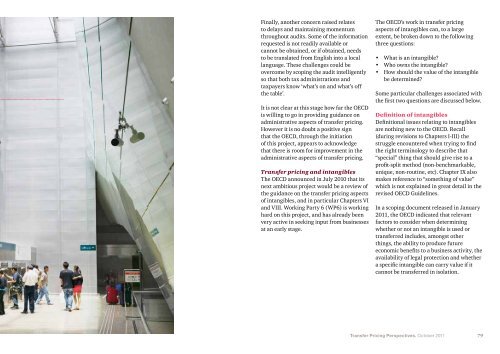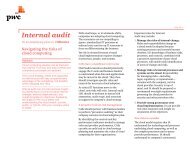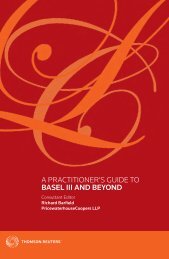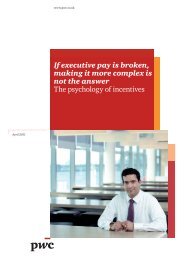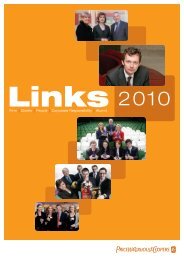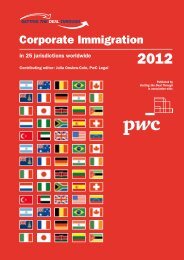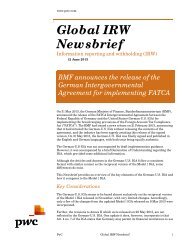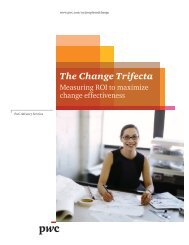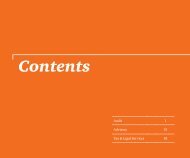Administrative aspects <strong>of</strong>transfer <strong>pricing</strong>On March 9, 2011 the OECD releasedan invitation for comments associatedwith the administrative aspects <strong>of</strong>transfer <strong>pricing</strong>. The work is regardedas important in order to strike a balancebetween the development <strong>of</strong> sophisticatedguidance for complex transactions, andthe cost‐effective use <strong>of</strong> taxpayer and taxadministration resources.The OECD is currently being encouragedto consider a variety <strong>of</strong> tools to helpfacilitate the administrative aspects <strong>of</strong>transfer <strong>pricing</strong>, including for example,safe harbours, risk assessment, operationalguidance, and the use <strong>of</strong> APAs, to namea few.Also note that in April 2011, the UK HMRevenue & Customs announced it hadagreed to take the lead on preparinga survey into the practicality <strong>of</strong> globaltransfer <strong>pricing</strong> guidelines (relating tothe OECD Forum on Tax Administration),which will also consider issues connected tothe OECD’s project.The OECD did not encourage the use<strong>of</strong> safe harbours in the past, out <strong>of</strong> fearthat such rules could negatively impactthe subsequent mutual agreementprocess, and increase the risk <strong>of</strong> doubletaxation. However, implementation <strong>of</strong>certain safe harbour rules for low valueservices could potentially help relievesome administration costs (both for taxadministrations and taxpayers), withoutnecessarily having a material impact on ajurisdiction’s taxable income. The OECD’sconcerns associated with the resultingmutual agreement process could also bealleviated by making it explicit that themutual agreement procedures take priority<strong>of</strong> safe harbour rules.The OECD is also being encouraged totake a closer look at risk assessments, anddevelop guidance on risk assessments formember states. This is to avoid situationswhere both tax administration andtaxpayer engage in lengthy and costlyaudits for what should be considered to below risk or immaterial transactions. Greateropenness and transparency associatedwith the triggers <strong>of</strong> an audit, as well asthe scoping <strong>of</strong> the agenda, could also leadto improvements. It could, for example,be helpful to see the fact-finding processbeing elaborated in advance and includingan analysis on which documents will needto be requested. Subsequent treatment bytrained transfer <strong>pricing</strong> <strong>of</strong>ficials is thenalso a key success factor, as it would ensurethat tax administration resources becomefocused on the important issues.Operational guidance as an effective toolwill also hopefully be considered by theOECD. Transparency, effectively achievedby the publication <strong>of</strong> operational guidancecan drive cooperation. Annual APA reports,training materials and announcement <strong>of</strong>transfer <strong>pricing</strong> enforcement plans, such asthose including an outline <strong>of</strong> the industriesthat are likely to receive increasedattention, are welcomed.Additional operational guidancewould be particularly welcome in thearea <strong>of</strong> comparables and data used forbenchmarking purposes, especially in theabsence <strong>of</strong> local comparables. Guidance –with respect to the use <strong>of</strong> multiple-year data– may also be helpful.Another tool that can help alleviate someadministrative aspects associated withtransfer <strong>pricing</strong> is the greater use <strong>of</strong>APAs. Although several OECD countriesdo have APA programmes, many areunder‐staffed, making the processextremely lengthy. Dedicating moreresources to APA programmes would allowtax administrations to deal with potentiallycomplex transactions in a more open andcooperative environment, in the long runfreeing up resources that can be dedicatedto less-cooperative taxpayers.Similarly, the OECD is also encouragedto think about a broadening <strong>of</strong> thecombination <strong>of</strong> APAs with rollbacks aswell as an effective use <strong>of</strong> mandatoryarbitration (Art 25(5) OECD Model TaxConvention, with an ever-growing group <strong>of</strong>countries including this possibility in theirbilateral treaties.Operationalguidance asan effectivetool will alsohopefully beconsidered bythe OECD78 <strong>Transfer</strong> Pricing Perspectives. October 2011
Finally, another concern raised relatesto delays and maintaining momentumthroughout audits. Some <strong>of</strong> the informationrequested is not readily available orcannot be obtained, or if obtained, needsto be translated from English into a locallanguage. These challenges could beovercome by scoping the audit intelligentlyso that both tax administrations andtaxpayers know ‘what’s on and what’s <strong>of</strong>fthe table’.It is not clear at this stage how far the OECDis willing to go in providing guidance onadministrative aspects <strong>of</strong> transfer <strong>pricing</strong>.However it is no doubt a positive signthat the OECD, through the initiation<strong>of</strong> this project, appears to acknowledgethat there is room for improvement in theadministrative aspects <strong>of</strong> transfer <strong>pricing</strong>.<strong>Transfer</strong> <strong>pricing</strong> and intangiblesThe OECD announced in July 2010 that itsnext ambitious project would be a review <strong>of</strong>the guidance on the transfer <strong>pricing</strong> aspects<strong>of</strong> intangibles, and in particular Chapters VIand VIII. Working Party 6 (WP6) is workinghard on this project, and has already beenvery active in seeking input from businessesat an early stage.The OECD’s work in transfer <strong>pricing</strong>aspects <strong>of</strong> intangibles can, to a largeextent, be broken down to the followingthree questions:• What is an intangible?• Who owns the intangible?• How should the value <strong>of</strong> the intangiblebe determined?Some particular challenges associated withthe first two questions are discussed below.Definition <strong>of</strong> intangiblesDefinitional issues relating to intangiblesare nothing new to the OECD. Recall(during revisions to Chapters I‐III) thestruggle encountered when trying to findthe right terminology to describe that“special” thing that should give rise to apr<strong>of</strong>it-split method (non‐benchmarkable,unique, non‐routine, etc). Chapter IX alsomakes reference to “something <strong>of</strong> value”which is not explained in great detail in therevised OECD Guidelines.In a scoping document released in January2011, the OECD indicated that relevantfactors to consider when determiningwhether or not an intangible is used ortransferred includes, amongst otherthings, the ability to produce futureeconomic benefits to a business activity, theavailability <strong>of</strong> legal protection and whethera specific intangible can carry value if itcannot be transferred in isolation.<strong>Transfer</strong> Pricing Perspectives. October 201179


